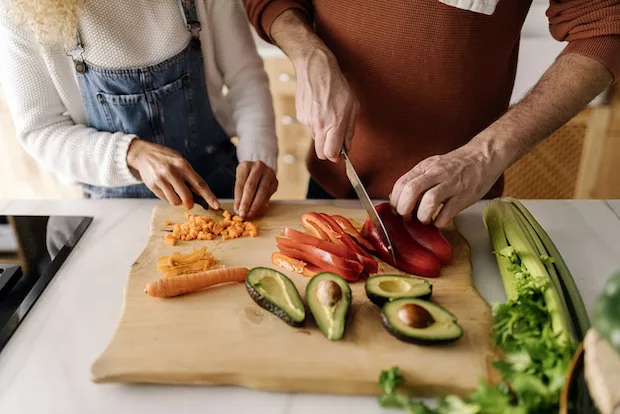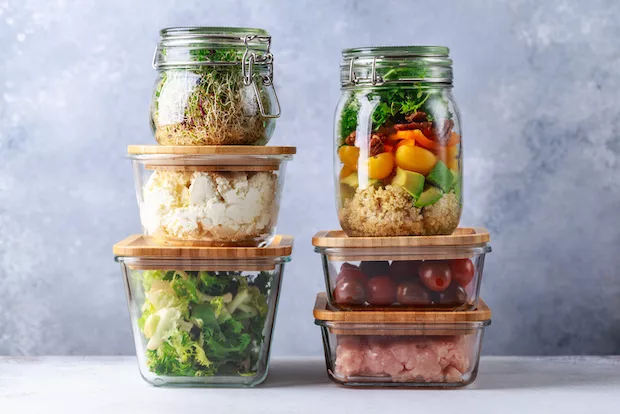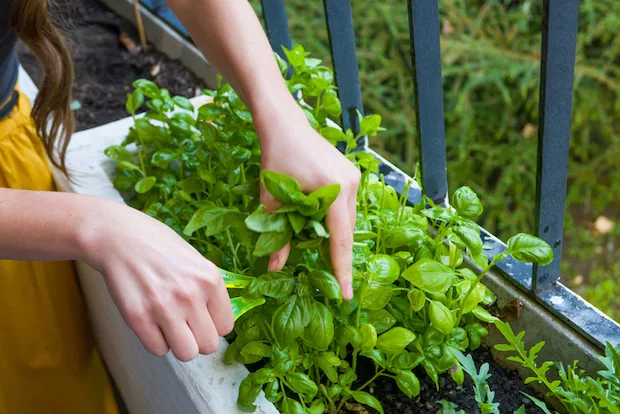To maximize nutrient intake while saving money, learn how to keep food fresh with must-follow tips from culinary experts. Plus: how to store potatoes, onions, apples, berries, and other fresh foods to max out their shelf lives.
As much as we love a night on the town, those restaurant outings don’t always love us back. Compared to dining out, cooking at home has been linked to better diet quality, improved mental health, and more money in your bank account—not to mention more time to invest in things other than worrying about what to wear. (That can’t be just us, right?)
That said, stocking up on ingredients to cook more homemade meals means that you’re at increased risk for food waste: a massive problem in the US and globally. A staggering 199 billion pounds of food is wasted each year in the US, according to estimates by Feeding America. This accounts to about 40 percent of all food grown or manufactured that’s later wasted rather than put to good use—and about 39 percent of the tossed food is falling victim to spoilage in our homes (rather than on farms or in restaurants, schools, hospitals, and other commercial uses).
If you buy in bulk or live in a small household, it can feel especially daunting to try to make it through your fresh produce, meats, and dairy items before they go bad. With this in mind—and since we’re on a collective quest to shift more towards a whole foods, plant-based diet—we’re rounding up our very best tips to keep fresh food fresh longer. With these pointers from culinary pros in your arsenal, you’ll have more time to meal prep and enjoy, rather than falling victim to the hands of time.
How to Keep Food Fresh, According to Pros
1. Live by “FIFO”
This is food industry speak for first-in, first-out. “While the practice doesn’t necessarily extend the life of fresh foods, it ensures you’re correctly rotating your fresh foods, which should help minimize food waste,” confirms Stephanie Michalak White, a Dayton, Kentucky-based chef instructor for culinary arts and plant-based culinary arts at Auguste Escoffier School of Culinary Arts.
When you put something new in, whether it’s produce or leftovers, position it further back and bring something older towards the front, recommends Lauren Grant-Vose, founder of Zestful Kitchen. “This allows you to keep eyes on your inventory and helps you keep track of what’s fresh and what’s a bit older and ready to be used.”
2. Create a showcase kitchen
As far as those first-out items go, Kristen Hong—a Dublin, California-based blogger at hellonutritarian.com and the author of Fridge Love—likes to create an ingredient “showcase” where she takes the fresh produce out of the crisper drawers and positions it at eye level to make it look inspiring to use. “It gives you a feeling of possibility when you open the fridge and see all your beautiful, colorful produce first thing,” she says.

3. Stay whole
While it can be tempting to meal prep up a storm and wash and chop everything so it’s ready to cook with in an instant, Grant-Vose suggests keeping things “whole” as long as you can. “If you’re planning to make something with shredded cabbage, for example, avoid shredding it too far in advance. The same holds true for whole heads of broccoli, cauliflower, bell peppers, cucumbers, lettuce, apples, pears and beyond,” Grant-Vose adds.
4. Know when to hold ‘em and when to cold ‘em
Placing fresh foods in cool, dry storage versus the refrigerator—depending on what’s best for each—can make a major difference in their lifespan, Michalak White advises. (Much more on that below.)
“Tomatoes are best at room temperature on the counter. If you place them in the refrigerator, they may get mealy. Other items, like mushrooms, should be refrigerated and may spoil quicker outside the refrigerator,” she says. Why are some items so temperamental? “This is predominantly due to different temperatures and humidity and moisture needs to keep ingredients as fresh as possible,” Michalak White explains.
5. Gear up and get organized
You don’t go on a massive shopping spree at The Container Store to become a food storage pro, Hong says. “I highly recommend starting off with pasta sauce jars. Raid your own recycling bin! I’ve done the comparisons in my own fridge and pasta sauce jars work just as well as Mason jars for produce storage.” However, if having a fully matching fridge inspires you to stress less and cook more, feel free.
Michalak White adores stackable, reusable glass containers with lids, and swears by masking tape and a permanent marker to label and date everything. If you do decide to up the ante, Grant-Vose has tested many items and can verify that the OXO Good Grips GreenSaver Produce Keeper extends the life of berries—that is, if you have room for it in your fridge. To keep food fresh longer without needing plastic wrap, she says she’s “obsessed” with Food Huggers Silicone Food Savers. “Beeswax wraps are also a great alternative,” she adds.
6. Remember these counter and fridge frenemies
You’ll want to identify ethylene-sensitive produce and ethylene-rich produce, Grant-Vose says—and tgen keep differing types away from each other. “Ethylene-rich produce like apples, avocados, stone fruits, tomatoes, melons, potatoes, and ripe bananas can cause ethylene-sensitive produce to ripen or deteriorate quicker,” she explains. “To be safe, just store these away from other produce, by themselves. The easiest rule to follow is to just store like produce together.”
Keep in mind that most of the testing regarding ethylene is usually based on food storage on a massive industrial scale, Hong counters, which means that “ethylene interactions will never be as pronounced in your home fridge as they would be in a cold-storage room. Plastic produce bags mitigate ethylene interactions. If you only have large crisper drawers, go ahead and keep a set of plastic produce bags for storage and wrap separate items individually, then store as you like.”
7. Utilize paper towels
They’re not just for soaking up spills any more. “Paper towels are a great way to extend the life of produce,” Grant-Vose says. “Berries, leafy greens, snap peas, and herbs can all benefit from a paper towel being placed in the storage container. Replace it with a fresh one occasionally if needed to absorb extra moisture.”

Tips for storing Your Go-To Foods
All that said, there’s no single food storage hack that reigns supreme for all fresh fare—so we’re breaking down individualized advice for some of the most popular and nutrititious picks below.
Tip: Need to fill in some dietary gaps? HUM’s Base Control contains 22 vitamins and minerals that support overall health and well-being.
Worth noting: “Every fridge is different. Plus, where you live and the time of year that it is will impact the overall shelf life you can expect from your fresh foods,” Hong says. Follow these general best practices, then check out the food spoilage section below, so you can perform a quality check wisely.
How to store potatoes
Store in a cool, dry place away from sunlight, such as a low cupboard or pantry shelf. You can also peel and chop potatoes and store them covered in water in your fridge for three to five days; simply rinse once more before using.
How to store onions
Store in a cool, dry place away from sunlight, such as a low cupboard or pantry shelf. Since onions are ethylene-sensitive and potatoes are ethylene-rich, it’s best to keep these two away from each other if you want to keep each fresh longer.
How to store apples and pears
Based on Hong’s home tests, apples ripen six to 10 times faster at room temperature than refrigerated. If you’re eating them within seven to 10 days, feel free to keep them at room temperature but away from direct light. For optimal lifespan, store both apples and pears in the produce drawer of your refrigerator; they should last for 10 days (pears) to six weeks (apples).
How to store leafy greens
Grant-Vose uses her OXO Good Grips Salad Spinner often and suggests reaching for it to speed up leafy green prep. Place the greens in the salad spinner and fill with cold water. Using clean hands, gently agitate the greens to help dislodge any dirt, then lift the basket out and dump the water. Place the basket back in the spinner and spin the greens dry. Store the greens in a large food storage container with a lid, with sheets of paper towels between layers to absorb excess water. Flip the container about every day or two. (This will deter water from pooling and will rotate weight concentration.) Eat leafy greens within seven days.
How to store berries
Don’t wash berries before storing them. Either keep in the plastic container the berries are sold in, or transfer to a glass container with a lid. Refrigerate in an area that’s distant from the airflow vents (likely near the front of any shelf) for up to seven days.

How to store fresh herbs
For leafy herbs like cilantro and parsley, rinse under a gentle stream of cold water, then shake or spin dry. Trim the stems (like a bouquet of flowers) and place the herbs, stem-side down, in a jar filled with an inch of water. Cover loosely with a plastic produce bag or reusable silicone bag to create a “tent.” Change the water every three to five days; these herbs should last up to two weeks.
For hardy herbs, such as rosemary and thyme, rinse under a gentle stream of cold water, then shake or spin dry. Wrap in a slightly damp paper towel, transfer to a zip-top plastic or reusable silicone bag, and store in the refrigerator crisper drawer for up to three weeks. (Chives, although tender, should be stored like a hardy herb and will last up to a week under these conditions.)
Basil is the one exception to these refrigerator rules. Trim the stems, then place the basil, stem-side down, in a jar filled with about an inch of water. Store, uncovered at room temperature and out of direct sunlight; it should last up to two weeks.
How to store meat
Store meat in the package you purchased it in. Place the packages on a small baking sheet (to catch any potential leaks) and store on the lowest shelf in the refrigerator, as far away from the door as possible. (We recommend this location since it’s the coldest place in the fridge.) If you don’t plan on using the meat within two days, transfer it to the freezer. The day before you plan to use frozen meat, move it back to the refrigerator and allow it to thaw overnight on a small baking sheet back on the lowest shelf in the refrigerator, away from the door.
How to store cheese
Wrap blocks of cheese tightly in plastic wrap, then transfer to zip-top plastic or reusable silicone bags. This should prevent them from drying out prematurely and/or melding flavors.
How to Know If Your Food Has Gone Bad
The number one factor that degrades our produce is temperature, Hong says, and it can make other factors—including humidity, water, and oxygen exposure—create more damage.
“Your nose will tell you if something is not quite right. Trust the smell for checking meat, seafood, dairy products, or produce” Grant-Vose says.
You can also use visual and textural cues. Ask yourself:
- Has it changed consistency?
- Is the fresh produce, cooked grains, or raw or cooked protein showing any signs of sliminess?
- Does the protein appear more gray in hue compared to when you first purchased it?
- Does the item have visible mold?
If there’s any funk or if you answer “yes” to any of the questions above, it’s time to toss it. When possible, reduce your food waste footprint by composting. “When in doubt, throw it out. We want to minimize food waste and get the most out of what we buy, but no one wants to get sick on questionable items,” Michalak White concludes.
The Takeaway
Just like no one supplement or skincare plan is right for every human, no one food storage tip reigns supreme for all products. Different foods require different storage protocols, and with these food safety and storage tips in your arsenal, you’ll be able to keep all of your food fresh for far longer than if you skipped these savvy prep steps.
But the process for maximizing the lifespan of your ingredients actually begins at the market, Michalak White shares.
“Take the time to evaluate your ingredients before purchasing them,” she says. “It’s also important to consider that nutrients break down steadily once something is harvested, even before they spoil. Depending on how far the item in question has traveled, this can cut into the shelf life once you buy and bring it home. Buy in season and local, when possible, to minimize distribution chains, support your local economy, and ensure your produce gives you as much nutritional bang for your buck.”
Build Your Supplement Routine
Take The HUM Quiz
The post 7 Tips & Tricks to Keep Food Fresh for *Much* Longer appeared first on HUM Nutrition Blog.
---------------------------
By: Karla Walsh
Title: 7 Tips & Tricks to Keep Food Fresh for *Much* Longer
Sourced From: www.humnutrition.com/blog/how-to-keep-food-fresh/
Published Date: Mon, 30 Jan 2023 02:32:00 +0000
Read More
Did you miss our previous article...
https://prohealthsciences.com/supplements-and-vitamins/you-should-try-these-4-pelvic-floor-exercises-because-its-not-just-kegels
 General Health and WellnessFitness and ExerciseSupplements and VitaminsPandemic NewsVideosPrivacy PolicyTerms And Conditions
General Health and WellnessFitness and ExerciseSupplements and VitaminsPandemic NewsVideosPrivacy PolicyTerms And Conditions
